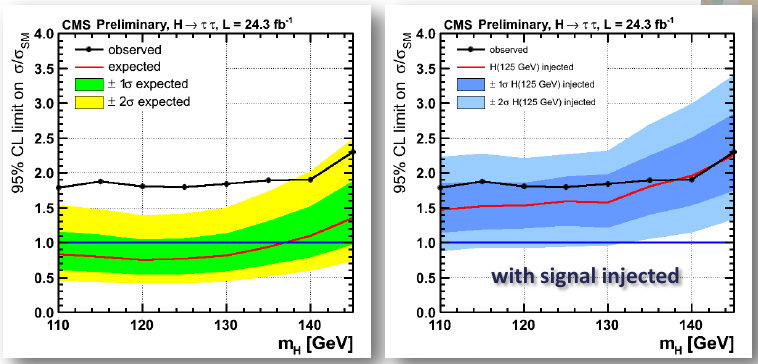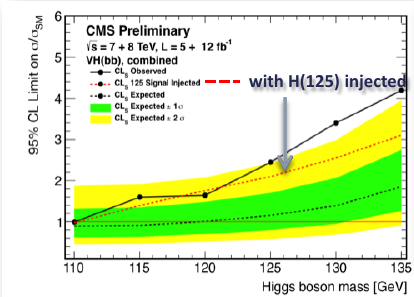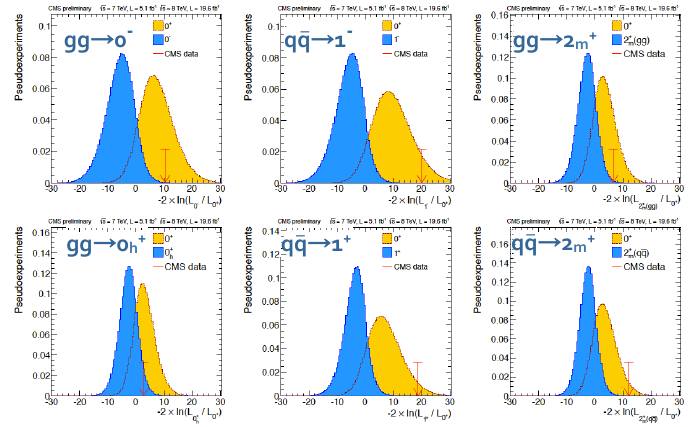Higgs updates from Moriond
Posted by David Zaslavsky on — CommentsThis week sees a major physics conference in Italy, the Rencontres de Moriond 2013 Electroweak session. It’s notable because the LHC experimentalists involved in the search for the Higgs boson are presenting their latest results. (There are also many other things being presented — less high-profile, but no less important!) I won’t give too many details of what has been presented, since there are plenty of other places on the web you can read about it, but certainly a quick overview is in order.
When last we left the Higgs search, it was November, and the experimentalists had just presented the results of analyzing the data the LHC had collected in the later half of summer 2012, combined in some cases with earlier data.
Of the various ways (channels) the standard model Higgs boson can decay, the experiments are looking most closely at these five:
- \(H\to\gamma\gamma\) (two photons)
- \(H\to WW\to ll\nu\nu\) (two leptons and two neutrinos)
- \(H\to ZZ\to 4l\) (four leptons)
- \(H\to \tlp\talp\) (two tau leptons)
- \(H\to \btq\btaq\) (bottom and antibottom quark)
Remember that if the particle discovered is really the standard model Higgs boson, it should decay via each of these channels exactly as often as predicted. As of last November, there were some hints that it might not be doing that: ATLAS and CMS had seen slightly more diphoton decays than predicted, and slightly fewer tau and bottom decays than predicted. It wasn’t conclusive evidence of anything, but physicists were holding out a little bit of hope that these slight discrepancies would become stronger as more data was collected, and would indicate something new to be discovered.
Unfortunately, with the new results presented yesterday, it looks more and more likely that the particle we’ve discovered is the plain old standard model Higgs boson, with no surprises. Both ATLAS and CMS are starting to release plots which show the number of observed events in a given channel compared to what is expected from the standard model with a Higgs boson with a mass of \(\SI{125}{GeV}\), and they match quite closely. For example, here are the plots from CMS [PDF] showing the numbers of \(\tlp\talp\) pairs detected,

and the numbers of \(\btq\btaq\) pairs detected,

In both cases, you can see that the lines for the observed counts are coming out above the green and yellow bands showing what would be expected if there were no Higgs boson, and are getting closer to the red lines showing what is expected with a \(\SI{125}{GeV}\) Higgs. There is still some excess in the \(\btq\btaq\) channel above \(\SI{125}{GeV}\), but that may well be a statistical fluke and has a decent chance of disappearing with time.
ATLAS is still seeing some more collisions than expected in the diphoton channel, but again, it’s not enough to strongly indicate that something unexpected is happening.
In addition to just looking at the different decay channels, physicists are also checking the spin and parity of the new particle, to check whether it matches the expectation for the standard model Higgs boson: zero spin and even parity. Back in November, that set of properties seemed most likely, but it wasn’t anywhere near conclusive. This week, both LHC experiments released more detailed analyses of the different possibilities for spin and parity the new particle could have. Here are some plots from CMS, for example:

Each graph shows a comparison of the standard model Higgs hypothesis, spin zero and even (+) parity (yellow), with another hypothesis (blue). The way to read these is to look at the height of each curve at the position of the red arrow. If one curve is much higher than the other, then one hypothesis is correspondingly much more likely than the other. You can see this in the center column, for example, where the height of the blue curve at the position of the arrow is essentially zero. That means that it’s exceedingly unlikely the new boson has spin one. (We know that it can’t have spin one if it’s a single particle, because it decays into two photons which each have spin one themselves, but if there are multiple particles with the same mass, it’s possible one of them has spin one, which is what those center graphs are exploring.) In some of the other plots, it’s clearly more likely that the new boson has spin zero and even parity, but not likely enough to eliminate the possibility outright. Quantitatively, all hypotheses other than \(0^+\) are excluded at a \(2\sigma\) level, which is short of the \(5\sigma\) exclusion that physicists would like to consider the matter closed.
New results aren’t the only things to come out of this conference, though. ATLAS has release some excellent animated GIFs showing how peaks emerge in the diphoton and four-lepton channels as you accumulate data over time. It’s rare to see a really good use of animation, and it’s also disappointingly rare to see a truly effective way of visualizing any scientific data, so this is a real treat. Observe and enjoy!